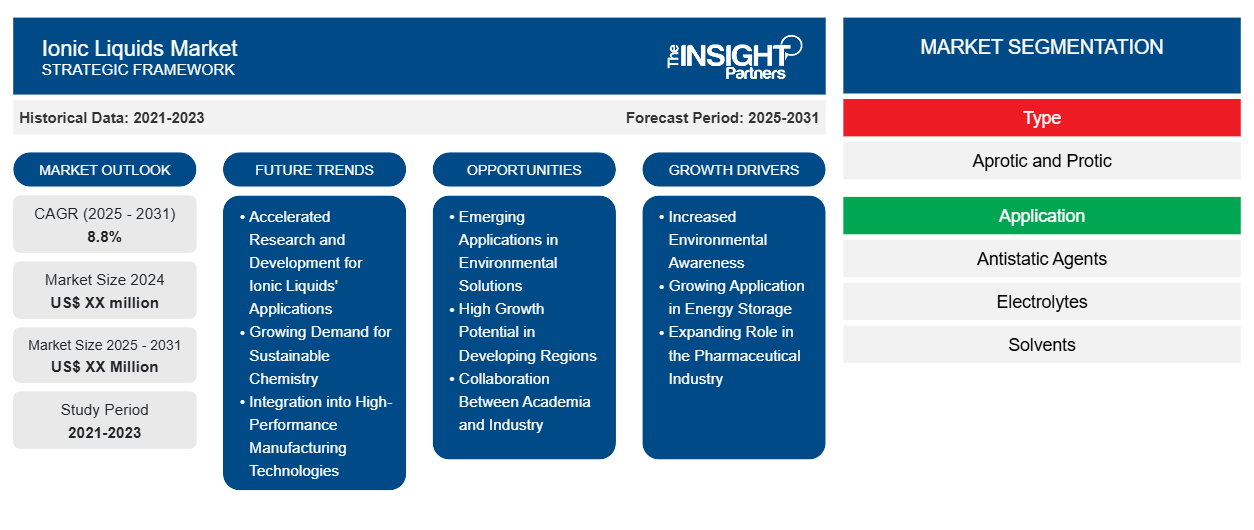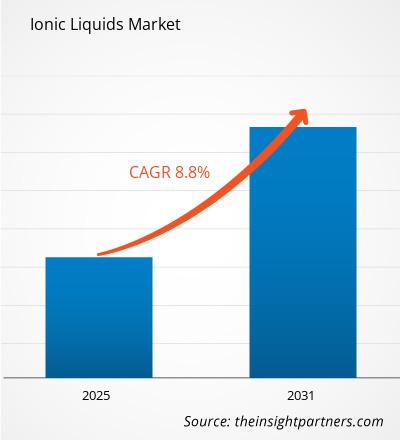The Ionic Liquids Market is expected to register a CAGR of 8.8% from 2025 to 2031, with a market size expanding from US$ XX million in 2024 to US$ XX Million by 2031.
The report is segmented by type (aprotic and protic). The report further presents an analysis based on the application (antistatic agents, electrolytes, solvents, PCO2 absorbents, lubricants, and others). The report scope covers five regions: North America, Europe, Asia Pacific, Middle East and Africa, and South and Central America and key countries under each region. The global analysis is further broken-down at regional level and major countries. The Report Offers the Value in USD for the above analysis and segments.
Purpose of the Report
The report Ionic Liquids Market by The Insight Partners aims to describe the present landscape and future growth, top driving factors, challenges, and opportunities. This will provide insights to various business stakeholders, such as:
- Technology Providers/Manufacturers: To understand the evolving market dynamics and know the potential growth opportunities, enabling them to make informed strategic decisions.
- Investors: To conduct a comprehensive trend analysis regarding the market growth rate, market financial projections, and opportunities that exist across the value chain.
- Regulatory bodies: To regulate policies and police activities in the market with the aim of minimizing abuse, preserving investor trust and confidence, and upholding the integrity and stability of the market.
Ionic Liquids Market Segmentation
Type
- Aprotic and Protic
Application
- Antistatic Agents
- Electrolytes
- Solvents
- PCO2 Absorbents
- Lubricants
You will get customization on any report - free of charge - including parts of this report, or country-level analysis, Excel Data pack, as well as avail great offers and discounts for start-ups & universities
Ionic Liquids Market: Strategic Insights

-
Get Top Key Market Trends of this report.This FREE sample will include data analysis, ranging from market trends to estimates and forecasts.
Ionic Liquids Market Growth Drivers
- Increased Environmental Awareness: Increased environmental awareness is propelling the demand for ionic liquids as green solvents. They dramatically reduce the VOCs of chemical processes, which fits into sustainability goals. In this scenario, industries look for the most eco-friendly alternatives in place of the traditional solvent, and hence ionic liquids are a prime choice for many applications.
- Growing Application in Energy Storage: Ionic liquids find increasing application in the field of energy storage due to their stability in terms of thermal, as well as electrochemical properties. Such compounds improve the efficiency of batteries and supercapacitors by rising the energy density and better safety. Demand for stable and efficient ionic liquids is likely to increase because of improved renewable energy technologies.
- Expanding Role in the Pharmaceutical Industry: The pharmaceutical industry is still growing the use of ionic liquids in the formulation and delivery of drugs. Ionic liquids bring added value to new medicines by improving the solubility and stability of active pharmaceutical ingredients. Consequently, innovation and investment keep flowing into research on ionic liquids with aims at improving drug efficacy and patient outcomes.
Ionic Liquids Market Future Trends
- Accelerated Research and Development for Ionic Liquids' Applications: High investment in research and development is making the knowledge of ionic liquids grow with their applications. Researchers are inventing new formulations and novel applications in a broad field of catalysis, extraction, and materials science. Increased R&D focus is accelerating the development of more flexible and performing ionic liquids.
- Growing Demand for Sustainable Chemistry: Increasingly high demand for sustainable chemistry, it forces industries towards using ionic liquids because of the environment. This type of solvent cuts waste and decreases the ecological footprints generated through the different chemical process steps. With this perspective, the introduction of ionic liquids meets one of the main world strategies in pursuit of making industries sustainable, namely, greener industrial practices.
- Integration into High-Performance Manufacturing Technologies: Ionic liquids are increasingly integrated into high-performance manufacturing technologies such as 3D printing and nanotechnology. Such fluids possess properties such as low volatility and characteristic tunability, which makes them enhance the efficiency of quality in these manufacturing processes. The recent trends therefore manifest a development towards more intensive use of ionic liquids in new forms of manufacturing technologies within and outside industry.
Ionic Liquids Market Opportunities
- Emerging Applications in Environmental Solutions: Ionic liquids have great scope in emerging applications such as carbon capture, renewable energy, and nanomaterials. As industries move further to find innovative solutions to environmental challenges, ionic liquids' unique properties will provide effective alternatives for efficient separation processes, energy storage, and new material developments to propel future market growth.
- High Growth Potential in Developing Regions: The ionic liquids market is highly growth-oriented in developing regions. With industrialization and the rising of environmental regulations, there is a growing demand for cleaner technologies. Once there is an awareness of ionic liquids, these cleaner solvents will be adopted much more rapidly by industries in developing regions, which in turn will open up further avenues for market expansion and collaboration.
- Collaboration Between Academia and Industry: The collaborative research efforts between academia and industry accelerate the development of new ionic liquid applications. Such collaborations utilize the strengths and resources of both sides, encourage innovation, and translate research into practical solutions. Such collaborations help align academic discoveries with market needs, thereby driving progress and expanding the commercial potential of ionic liquids.
Ionic Liquids Market Regional Insights
The regional trends and factors influencing the Ionic Liquids Market throughout the forecast period have been thoroughly explained by the analysts at The Insight Partners. This section also discusses Ionic Liquids Market segments and geography across North America, Europe, Asia Pacific, Middle East and Africa, and South and Central America.
Ionic Liquids Market Report Scope
| Report Attribute | Details |
|---|---|
| Market size in 2024 | US$ XX million |
| Market Size by 2031 | US$ XX Million |
| Global CAGR (2025 - 2031) | 8.8% |
| Historical Data | 2021-2023 |
| Forecast period | 2025-2031 |
| Segments Covered |
By Type
|
| Regions and Countries Covered |
North America
|
| Market leaders and key company profiles |
|
Ionic Liquids Market Players Density: Understanding Its Impact on Business Dynamics
The Ionic Liquids Market is growing rapidly, driven by increasing end-user demand due to factors such as evolving consumer preferences, technological advancements, and greater awareness of the product's benefits. As demand rises, businesses are expanding their offerings, innovating to meet consumer needs, and capitalizing on emerging trends, which further fuels market growth.

- Get the Ionic Liquids Market top key players overview
Key Selling Points
- Comprehensive Coverage: The report comprehensively covers the analysis of products, services, types, and end users of the Ionic Liquids Market, providing a holistic landscape.
- Expert Analysis: The report is compiled based on the in-depth understanding of industry experts and analysts.
- Up-to-date Information: The report assures business relevance due to its coverage of recent information and data trends.
- Customization Options: This report can be customized to cater to specific client requirements and suit the business strategies aptly.
The research report on the Ionic Liquids Market can, therefore, help spearhead the trail of decoding and understanding the industry scenario and growth prospects. Although there can be a few valid concerns, the overall benefits of this report tend to outweigh the disadvantages.
Frequently Asked Questions
What is the furture trend for ionic liquids market?
What are the deliverable formats of the ionic liquids market?
Which regions are covered in the report?
What are the key players operating in the ionic liquids market?
What are the driving factors impacting the ionic liquids market?
1. Ionic liquids are eco-friendly alternatives, reducing VOC emissions.
2. They enhance drug formulation and delivery by improving solubility.
What is the expected CAGR of the Ionic Liquids Market?
- Historical Analysis (2 Years), Base Year, Forecast (7 Years) with CAGR
- PEST and SWOT Analysis
- Market Size Value / Volume - Global, Regional, Country
- Industry and Competitive Landscape
- Excel Dataset
Recent Reports
Testimonials
Reason to Buy
- Informed Decision-Making
- Understanding Market Dynamics
- Competitive Analysis
- Identifying Emerging Markets
- Customer Insights
- Market Forecasts
- Risk Mitigation
- Boosting Operational Efficiency
- Strategic Planning
- Investment Justification
- Tracking Industry Innovations
- Aligning with Regulatory Trends





















 Get Free Sample For
Get Free Sample For